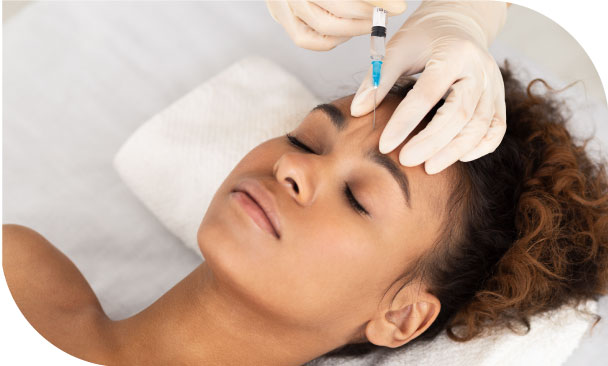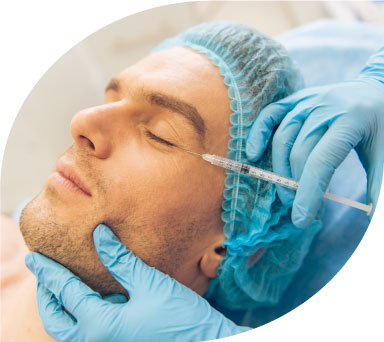
THE BEAUTY OF BOTOX
Botox has been a trusted solution for decades.
The American Society of Plastic Surgeons claims it is the number one minimally invasive cosmetic procedure in the United States. Botox successfully treats moderate to severe facial wrinkles and is approved by the Food & Drug Administration (FDA) for treating crow’s feet around the eyes, forehead lines, and frown lines.
Botox injections can be used alone or with fillers to reduce the appearance of both dynamic and static wrinkles. Dynamic wrinkles are those that appear while a person is actively smiling, frowning, or making some other facial movement. Botox relaxes the surrounding muscles and decreases their activity, reducing the appearance of lines.
Static wrinkles are those that are on the face permanently and are caused by smoking or sun damage. With static wrinkles, a medical professional may use a facial filler, along with Botox, to plump and smooth lines, which can also be used to reduce the look of lines on the chin, mouth, and lips, including marionette lines.

MAEZ Integrative Healthcare’s licensed medical professionals will discuss options and a treatment plan with each client during their initial consultation. Injections can often be done on the same day.
HOW DOES
BOTOX WORK?
Various factors cause facial lines and wrinkles as people age, such as reduced collagen, cellular changes, and skin damage caused by the sun and other environmental factors. A primary cause is repeated muscle contractions from smiling, squinting, frowning, raising the eyebrows, and other facial movements. Botox contains botulinum toxin type A that temporarily prevents these muscles from moving. It works below the surface to reduce muscle activity, resulting in visibly smoother-looking skin. Millions of people enjoy the benefits of a younger-looking appearance with Botox, along with the following other benefits:
Can Botox Treat Medical Conditions?
Botox is effective in treating various medical conditions by relieving a client’s symptoms. The FDA has approved the following therapies:
How Should I Prepare for My Appointment?
Botox must be dispensed by a licensed medical professional and is often administered in a medical office. Most professionals undergo training specifically for administering Botox. There can be adverse reactions if administered incorrectly. Clients will need to start with a consultation. During this appointment, the client will complete paperwork that includes their medical history. Clients should be prepared to disclose and discuss the following:
During the consultation, medical professionals will ascertain goals and recommend a treatment plan. If the client is a good candidate, they are often treated at the same appointment. Many people do not feel discomfort during the procedure, but some do. If Botox is being used for medical treatment, a client can choose to have a medical professional numb the treatment area using a topical numbing agent or ice and vibration anesthesia.
A medical professional will then use a thin needle to inject tiny amounts of the toxin into the skin or muscles. The number of injections and the amount needed will depend on the treatment’s use and the extent of the affected area. Each client is different, so injections will vary. After treatment, the client will be advised to avoid rubbing or massaging the treated areas for 24 hours to prevent the Botox from spreading to other sites. Clients can resume normal activities immediately after treatment.
FREQUENTLY ASKED QUESTIONS
Q:
Is Botox Painful?
A:
Some clients often describe the injection as a pinch. Numbing agents can be applied to any client who is worried about discomfort.
Q:
How Many Injections Will I Need?
A:
It depends on the severity and extent of areas needing treatment, a person’s facial makeup, and their customized treatment plan. The following are general guidelines: • Crow’s feet: About three injections, Frown lines: About five injections, Forehead lines: About five injections, Medical uses: No average amount
Q:
How Often Do I Need Injections?
A:
Botox is not a permanent treatment. Most cosmetic treatments last four months, but every client is different. Lines and wrinkles will gradually return if the client stops treatment.
Q:
Will I Look Unnatural?
A:
Botox is meant to provide subtle, natural-looking results. Medical professionals will target the right areas to ensure clients look like themselves but with fewer noticeable lines and wrinkles.
Q:
Is Botox Just for Women?
A:
Both men and women enjoy the benefits of Botox.
Q:
How Old Do I Have to Be to Receive Treatments?
A:
Most clients choose their late 30s or 40s to begin a treatment plan, but others start treatment in their 60s or 70s.




 Linwood Cosmetic Specialists at MAEZ Integrative Healthcare Offer Botox Treatments to Clients with Various Needs
Linwood Cosmetic Specialists at MAEZ Integrative Healthcare Offer Botox Treatments to Clients with Various Needs